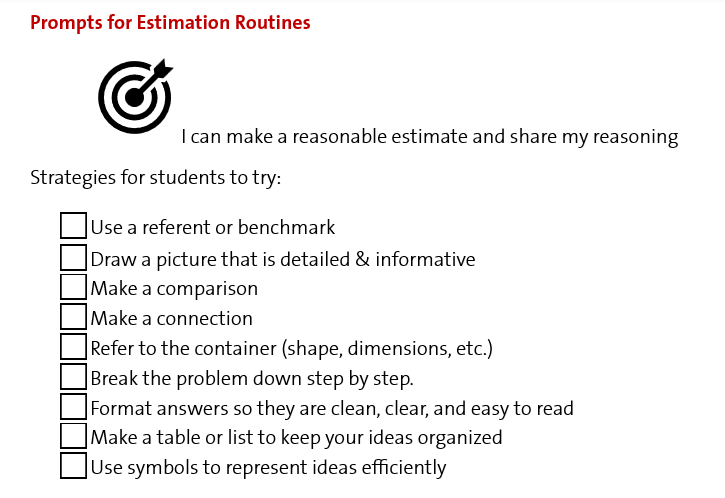IV. Automaticity & Mental Math
"Even more important than performing computational procedures or using calculators is the greater facility that students need—more than ever before— with estimation and mental math” (NCTM, May 2005)
Definitions | ||
|---|---|---|
Automaticity The ability to recall basic number facts and apply procedures quickly, accurately, and effortlessly, without needing to stop and consciously work through each step. Automaticity supports more complex learning by freeing up mental energy (working memory) for problem solving, reasoning, and communication. It is not just speed—it is fluency grounded in understanding. | Mental Math The ability to perform calculations in one’s head using flexible strategies, number sense, and understanding of mathematical relationships—without relying on paper, pencil, or a calculator. Why it matters: Mental math builds confidence, promotes numerical reasoning, and allows students to adapt their strategies to fit different contexts. It emphasizes how and why a solution works, not just the answer. | |
Estimation The skill of finding a reasonable, approximate answer to a problem using rounding, benchmarks, or logical reasoning. Why it matters: Estimation is essential for real-life math. It helps students judge the reasonableness of answers, make predictions, and problem-solve when precision isn’t required—or before precision is possible. It’s also a key part of developing number sense. | Computational Fluency Refers to developing efficiency, accuracy, and flexibility in reasoning and calculating. Why it matters: Students fluent with mental mathematics “become liberated from calculator dependence, build confidence in doing mathematics, become more flexible thinkers and are more able to use multiple approaches to problem solving” (NCTM, 2015) | |
According to the current BC math curriculum, mental math strategies and estimation are competencies required for reasoning and analyzing information. Students who can confidently and consistently perform mental mathematics, including determining reasonable estimates, are better able to engage with more challenging and diverse mathematical explorations.
| Resource Description | Resource Link | |
| 1 | Tips for Estimating Reasonably | Ten Steps to Estimate Reasonably Infographic |
| 2 | Guide to games for building fluency | Automaticity Games List |
| 3.1 | Simple tracking sheet for recording subitizing in early primary (K/1) | Gr. 1 Subitizing Record |
| 3.2 | Card Flip Addition (use regular cards 1-10) by Mary Deagle Kindergarten & Grade 1 | Card Flip Addition Game Template |
| 4 | Math Fact Fluency Research | Article: 5 Fundamentals Fluency |
| 5 | Daily number sense / fluency-building routine (K-5) | Mystery Number Routine |
| 6.1 | Counting and number facts placemat template (K-2) | Fact Bowls K-2 |
| 6.2 | Operational fluency placemat template (Grade 3+) | Fact Bowls Grade 3+ |
| 7 | Tips for selecting better fluency-building games (Grade 3+) | 10 Questions to Guide Game Selection |
| 8 | 1-page (PDF) guide to Steve Wyborney's Esti-Mysteries (Grades 3-5) | Esti-Mystery Grade Level Guide |
| 9.1 | Article by Jo Boaler (Youcubed) | Fluency Without Fear: Best Ways to Learn Math Facts |
| 9.2 | Understanding fluency (article) | Fluency: Simply Fast and Accurate: NCTM Article |
Strategies to Improve Mental Math and Estimation
No Calculators One strategy to improve mental mathematics is to not allow students the use of calculators when working with whole numbers. Developing number sense through routines like number talks and games that reinforce knowledge of basic facts is recommended. Eliminating the use of calculators prevents students from using the calculators unnecessarily and forces them to improve their number sense. Number Line Estimation A great example of estimation is asking students to place a variety of powers, radicals, fractions, etc. onto a number line. This really shows a student's number sense and understanding of the numerical value of different number forms. Mental Math Mondays Developed by Howie Hua, Mental Math Monday routines are a fun way to get students thinking flexibly and fluently about number. Estimate First Dan Meyer emphasizes the importance of getting students to make an estimate before attempting to solve a problem. You can ask students to make three estimates, one they know is too low, one they know is too high, and one they think is correct. This kind of “Goldilocks” estimation supports the understanding of domain and range and other key concepts in later grades. Esti-Mysteries and Estimation 180 Both estimation routines are highly engaging and effective. Potential learning intentions for curricular competencies include:
| "A varied instructional approach is recommended to help students gain fluency and flexibility with number facts" (Brendtro, 2019). High-Yield Routines Web-based instructional resources, including recommended lesson materials can be found using the links below. High Yield Routines build fluency, conceptual understanding, communication, and critical thinking skills.  Additional ways to support the development of mental math and estimation skills are:
|




